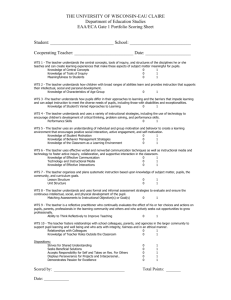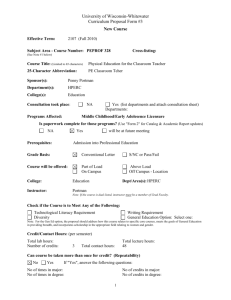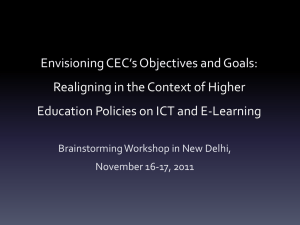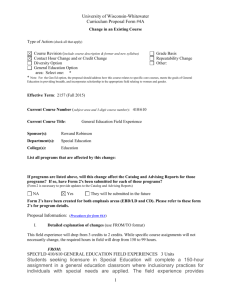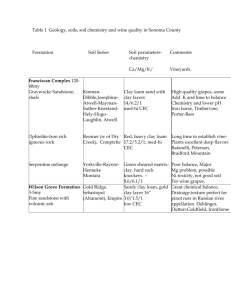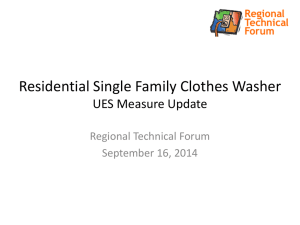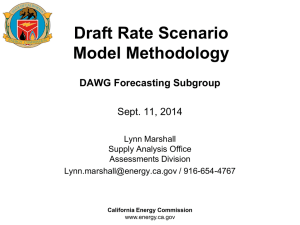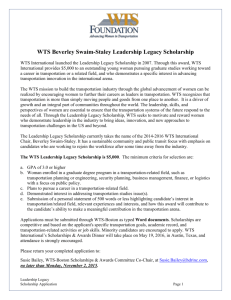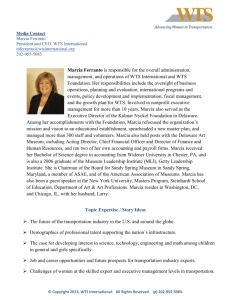Student id #: Placement - University of Wisconsin Whitewater
advertisement
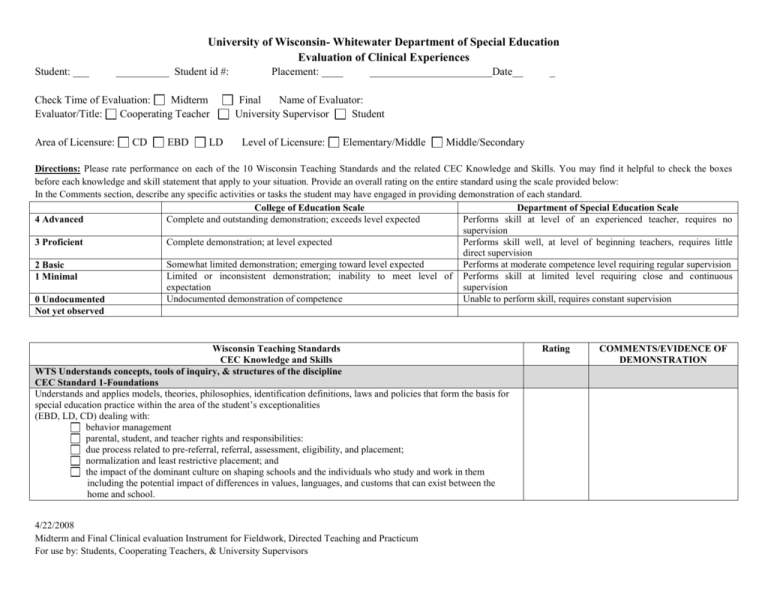
University of Wisconsin- Whitewater Department of Special Education Evaluation of Clinical Experiences Student: ___ __________ Student id #: Check Time of Evaluation: Midterm Evaluator/Title: Cooperating Teacher Area of Licensure: CD EBD LD Placement: ____ _______________________Date__ _ Final Name of Evaluator: University Supervisor Student Level of Licensure: Elementary/Middle Middle/Secondary Directions: Please rate performance on each of the 10 Wisconsin Teaching Standards and the related CEC Knowledge and Skills. You may find it helpful to check the boxes before each knowledge and skill statement that apply to your situation. Provide an overall rating on the entire standard using the scale provided below: In the Comments section, describe any specific activities or tasks the student may have engaged in providing demonstration of each standard. College of Education Scale Department of Special Education Scale Complete and outstanding demonstration; exceeds level expected Performs skill at level of an experienced teacher, requires no 4 Advanced supervision Complete demonstration; at level expected Performs skill well, at level of beginning teachers, requires little 3 Proficient direct supervision Somewhat limited demonstration; emerging toward level expected Performs at moderate competence level requiring regular supervision 2 Basic Limited or inconsistent demonstration; inability to meet level of Performs skill at limited level requiring close and continuous 1 Minimal expectation supervision Undocumented demonstration of competence Unable to perform skill, requires constant supervision 0 Undocumented Not yet observed Wisconsin Teaching Standards CEC Knowledge and Skills WTS Understands concepts, tools of inquiry, & structures of the discipline CEC Standard 1-Foundations Understands and applies models, theories, philosophies, identification definitions, laws and policies that form the basis for special education practice within the area of the student’s exceptionalities (EBD, LD, CD) dealing with: behavior management parental, student, and teacher rights and responsibilities: due process related to pre-referral, referral, assessment, eligibility, and placement; normalization and least restrictive placement; and the impact of the dominant culture on shaping schools and the individuals who study and work in them including the potential impact of differences in values, languages, and customs that can exist between the home and school. 4/22/2008 Midterm and Final Clinical evaluation Instrument for Fieldwork, Directed Teaching and Practicum For use by: Students, Cooperating Teachers, & University Supervisors Rating COMMENTS/EVIDENCE OF DEMONSTRATION University of Wisconsin- Whitewater Department of Special Education Evaluation of Clinical Experiences WTS The teacher understands how children with a broad ability learn CEC Standard 2 – Development and Characteristics of Learners Knows typical and atypical human growth and development as relates to the educational implications of characteristics of various exceptionalities in the following areas: social, psychological neurobiological, physical/motor development, and medical aspects; effects of various medications; effects of the family system, cultural and environmental milieu of the individual; and factors that influences overrepresentation of diverse individuals in programs WTS The teacher understands how pupils differ in their approaches to learning CEC Standard 3: Individual Learning Differences Understands the effects an exceptional condition(s) can have on an individual’s life including: impact of co-existing conditions, multiple disabilities, and medical conditions; impact of academics and social abilities (particularly the effects of phonological awareness on reading) attitudes, interests, and values on instruction and career development; impact of culturally diverse backgrounds and strategies for addressing these differences; and impact disabilities may have on auditory and information processing skills. WTS The teacher understands how to use a variety of instructional strategies CEC Standard 4-Instructional Strategies Uses strategies to facilitate successful integration in the following settings: transition of individuals into and out of school and post-school environments; one-to-one, small-group, and large-group settings instructional settings; and instruction on basic structures and relationships, concepts/content, and vocabulary, in the general curriculum Teaches individuals to use self-assessment, problem solving, and other cognitive strategies including: compensate for deficits in perception, comprehension, memory, and retrieval; use responses and errors to guide instructional decisions and provide feedback to learners; use study skills/strategies to prepare for and take tests, identify and organize critical content, facilitate maintenance and generalization of skills across learning environments; solve problems; and use procedures to increase the individual’s self-awareness, self-management, self-control, self-reliance, and self-esteem. Selects, adapts, and uses instructional strategies and materials from multiple theoretical approaches to: use nonaversive techniques to control targeted behavior and maintain attention; use specialized methods for teaching basic skills including accuracy and proficiency in math calculations and applications, appropriate reading methods (decoding, comprehension, and monitoring strategies), and strategies for organizing and composing written products; and modify the pace of instruction and provide organizational cues as appropriate. 4/22/2008 Midterm and Final Clinical evaluation Instrument for Fieldwork, Directed Teaching and Practicum For use by: Students, Cooperating Teachers, & University Supervisors University of Wisconsin- Whitewater Department of Special Education Evaluation of Clinical Experiences WTS: The teacher uses an understanding of individual and group motivation and behavior CEC Standard 5-Learning Environments and Social Interactions Applies basic classroom management theories and strategies, uses performance data and information from all stakeholders to create positive learning environments, and uses the least intensive behavior management strategy consistent with the needs of the individual by: setting realistic expectations for personal and social behavior in various settings; teaching problem solving and conflict resolution and giving and receiving meaningful feedback from peers and adults in a variety of placement settings, including community- based settings applying strategies for crises prevention and intervention and applying universal precautions; allowing individuals to retain and appreciate their own and each other’s respective language and cultural heritage and cope with a legacy of former and continuing racism; using the supports needed for assistive technologies and transfer/lifting/positioning; establishing a consistent classroom routine; and structuring, directing, and supporting the activities of par educators, volunteers, and tutors. WTS: The teacher uses effective verbal and nonverbal communication CEC Standard 6 Language Uses strategies to support/enhance communication skills of individuals and facilitate understanding of subject matter for students whose primary language is not the dominant language by: understanding the impact of language development and listening comprehension on academic and nonacademic learning; enhancing vocabulary development and teaching strategies for spelling accuracy and generalization; teaching methods and strategies for producing legible documents; and monitoring for errors in oral and written communications; and applying augmentative, alternative, and assistive communication strategies. WTS: The teacher organizers and plans systematic instruction based upon knowledge of subject matter, pupils, the community and curriculum goals. CEC Standard 7- Instructional Planning. Demonstrates understanding of the scope and sequences of general and special curricula by: including model programs in career/vocational transition; designing and implementing sensory stimulation programs; applying technology for planning and managing; using task analysis and functional assessments to plan and implement individualized academic programs, reinforcement systems and environmental modifications; developing and implementing comprehensive, individualized programs for children at risk in collaboration with professionals, families, and selected related services; integrating affective, social, and life skills with academic curricula including behavior management, personal living, sexuality, and employment; identifying and prioritizing areas of general curriculum needing accommodations; preparing and organizing age and ability appropriate specialized curricula, materials, and lesson plans; and directing roles and responsibilities of the par educator 4/22/2008 Midterm and Final Clinical evaluation Instrument for Fieldwork, Directed Teaching and Practicum For use by: Students, Cooperating Teachers, & University Supervisors University of Wisconsin- Whitewater Department of Special Education Evaluation of Clinical Experiences WTS: The teacher uses formal and informal assessment strategies CEC Standard 8-Assessment Develops or modifies individualized assessment strategies including choosing and administering non-biased formal and informal assessment instruments. Gathers relevant background information to develop or modify individualized assessment strategies. Creates and maintains records. Includes behavior rating scales and adaptive behavior assessments to determine appropriate and problematic social behaviors. Makes eligibility, program, and placement decisions for individuals, including those from culturally and/or linguistically diverse backgrounds. Reports assessment results to all stakeholders using effective communication skills. Evaluates instruction and monitors progress of individuals. Use technology to conduct assessments. WTS: The teacher is a reflective practitioner CEC Standard 9 – Professional and Ethical Practice Practices within the CEC Code of Ethics and other standards of the profession. Conducts professional activities in compliance with applicable laws and policies. Participates in activities of professional organizations and use research findings and theories to guide practice. Engages in professional activities that benefit students, their families, and one’s colleagues. Advocates for appropriate services. Demonstrates sensitivity for the culture, language, religion, gender, disability, socio-economic status, and sexual orientation of individuals. Conducts self-evaluation of instruction and reflect on one’s practice to improve instruction and guide professional growth. Uses verbal, nonverbal, and written language effectively. WTS: The teacher fosters relationships CEC Standard 10 - Collaboration Collaborates with school personnel, parents, and community services, networks, and organizations community integrating students into various settings and while engaging in: assessment and IEP development; co-planning, co-teaching, modeling, and coaching of instructional methods and accommodations, appropriate behavior management and counseling techniques, and transitional programming; and interactions with par educators. 4/22/2008 Midterm and Final Clinical evaluation Instrument for Fieldwork, Directed Teaching and Practicum For use by: Students, Cooperating Teachers, & University Supervisors

